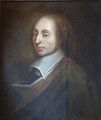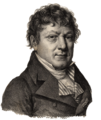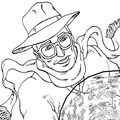Template:Selected anniversaries/August 19: Difference between revisions
No edit summary |
No edit summary |
||
| Line 31: | Line 31: | ||
||1830: Julius Lothar Meyer born ... chemist who discovered the Periodic Law, independently of Dmitry Mendeleyev, at about the same time (1869). However, he did not develop the periodic classification of the chemical elements as thoroughly as Mendeleyev. Meyer trained originally in medicine and chemistry. He examined the effect of carbon monoxide on blood. In 1879, Meyer compared atomic volume to atomic weight. Plotted on a graph, the curve showed the periodicity of the elements. He also established the concept of valency by indicating that a given element combined with a characteristic number of hydrogen atoms, and coined the terms like univalent, bivalent, and trivalent, based on that number. Pic. | ||1830: Julius Lothar Meyer born ... chemist who discovered the Periodic Law, independently of Dmitry Mendeleyev, at about the same time (1869). However, he did not develop the periodic classification of the chemical elements as thoroughly as Mendeleyev. Meyer trained originally in medicine and chemistry. He examined the effect of carbon monoxide on blood. In 1879, Meyer compared atomic volume to atomic weight. Plotted on a graph, the curve showed the periodicity of the elements. He also established the concept of valency by indicating that a given element combined with a characteristic number of hydrogen atoms, and coined the terms like univalent, bivalent, and trivalent, based on that number. Pic. | ||
||1839: Louis Daguerre announces the invention of the daguerreotype photographic process, the first process to allow an image to be chemically fixed as a permanent picture. On 7 Jan 1839 an announcement was made of the discovery, but details were not divulged until 19 Aug, when the process was announced publicly, and the French government having bought the rights to the process from him, freely gave them to the world. However, this process had also been patented in England and Wales on 14 Aug 1839, only five days previously. | |||
||1854: The First Sioux War begins when United States Army soldiers kill Lakota chief Conquering Bear and in return are massacred. | ||1854: The First Sioux War begins when United States Army soldiers kill Lakota chief Conquering Bear and in return are massacred. | ||
| Line 37: | Line 39: | ||
||1871: Orville Wright, American engineer and pilot, co-founded the Wright Company. | ||1871: Orville Wright, American engineer and pilot, co-founded the Wright Company. | ||
||1876: George Smith dies ... archaeologist and Assyriologist who translated Babylonian cuneiform tablets (1872) describing a great deluge, part of the Gilgamesh epic, and akin to that found in Genesis. Smith, as an apprentice banknote engraver since age 14, spent much of his own time teaching himself how to decipher cuneiform, by studying inscriptions available at the British Museum. His skill was recognized, and he worked for the British Museum from 1867. Smith engaged in fieldwork in 1873 at Nineveh (Kuyunjik) finding more tablet fragments of the flood story, and others on the Babylonian dynasties. He published his work in The Chaldean Account of Genesis (1876). He died at age 36 of a fever while excavating more of Assurbanipal's library. Pic. | |||
||1883: Leonid Kulik born ... minerologist who conducted the first scientific expedition (for which records survive) to study the Tungusta meteor impact site. He began in 1927, and continued to work on the investigation until, while fighting for his country in WW II, he was captured and died of typhus in a Nazi prison camp. Pic. | ||1883: Leonid Kulik born ... minerologist who conducted the first scientific expedition (for which records survive) to study the Tungusta meteor impact site. He began in 1927, and continued to work on the investigation until, while fighting for his country in WW II, he was captured and died of typhus in a Nazi prison camp. Pic. | ||
||1887: Alvan Clark dies ... astronomer whose family became the first significant manufacturers of astronomical instruments in the U.S. His company manufactured apparatus for most American observatories of the era, including Lick and Pulkovo, and others in Europe. In 1862, while testing a telescope, Clark discovered the companion star to Sirius, which had previously been predicted but until then never sighted. The 18½-in objective telescope he used was subsequently delivered to the Dearborn Observatory, Chicago. His sons, Alvan Graham Clark and George Bassett Clark, continued the business. The unexcelled 40-in refractor telescopes for the 40-in Yerkes observatory was made by Alvan Graham Clark. Pic. | ||1887: Alvan Clark dies ... astronomer whose family became the first significant manufacturers of astronomical instruments in the U.S. His company manufactured apparatus for most American observatories of the era, including Lick and Pulkovo, and others in Europe. In 1862, while testing a telescope, Clark discovered the companion star to Sirius, which had previously been predicted but until then never sighted. The 18½-in objective telescope he used was subsequently delivered to the Dearborn Observatory, Chicago. His sons, Alvan Graham Clark and George Bassett Clark, continued the business. The unexcelled 40-in refractor telescopes for the 40-in Yerkes observatory was made by Alvan Graham Clark. Pic. | ||
||1887: Dmitri Ivanovich Mendeleev uses a balloon to ascend above the cloud cover to an altitude of 11,500 feet (3.5 km) to observe an eclipse in Russia. He made the solo ascent above Klin without any prior experience. While his family was rather concerned, he paid no attention to controlling the balloon until after he had completed his observations, at which time he worked out how to land it. Mendeleev is the Russian chemist known for the ordering of the Periodic Table of the Elements. Yet, he was interested in many fields of science. He studied problems associated with Russia's natural resources, such as coal, salt, metals, and the petroleum industry. In 1876, he visited the U.S. to observe the Pennsylvania oil fields. | |||
||1888: Erik Edlund dies ... physicist. His scientific research was confined chiefly to the theory of electricity. He helped secure the introduction of weather stations to Sweden. | ||1888: Erik Edlund dies ... physicist. His scientific research was confined chiefly to the theory of electricity. He helped secure the introduction of weather stations to Sweden. | ||
| Line 61: | Line 67: | ||
||1940: First flight of the B-25 Mitchell medium bomber. | ||1940: First flight of the B-25 Mitchell medium bomber. | ||
||1947: The first full synthesis route for vitamin A was found by Dutch chemists, Jozef Ferdinand Arens and David Adriaan van Dorp. Later in 1947, a team headed by O. Isler also synthesized vitamin A using a method more suitable to produce commerical quantities. | |||
||1950: Giovanni Giorgi dies ... physicist and engineer. | ||1950: Giovanni Giorgi dies ... physicist and engineer. | ||
| Line 72: | Line 80: | ||
||1960: Sputnik program: Korabl-Sputnik 2: The Soviet Union launches the satellite with the dogs Belka and Strelka, 40 mice, two rats and a variety of plants. | ||1960: Sputnik program: Korabl-Sputnik 2: The Soviet Union launches the satellite with the dogs Belka and Strelka, 40 mice, two rats and a variety of plants. | ||
||1964: Syncom 3, the first geostationary communication satellite, | ||1960, the first commercial atomic energy reactor, and the third in the U.S., achieved a self-sustaining nuclear reaction. It began producing power for distribution on 10 Nov 1960. This was the $57 million Yankee Atomic Electric Company's plant at Rowe, Mass., on the Deerfield River. The pressurized light-water reactor produced 125,000 kilowatts of electricity. The company was formed by twelve New England utility companies which signed a contract with the Westinghouse Corporation as the principal contractor. It was permanently shut down on 26 Feb 1992, due to reactor vessel embrittlement, after more than 31 years of service. Decommissioning began in 1993. | ||
||1964: Syncom 3, the first geostationary communication satellite, is launched. | |||
||1967: Hugo Gernsback dies ... inventor (80 patents) and publisher who was largely responsible for the establishment of science fiction as an independent literary form. Hugo founded radio station WRNY, was involved in the first television broadcasts and is considered a pioneer in amateur radio. In 1926, as owner of a magazine, Modern Electrics, he filled a blank spot in his publication by dashing off the first chapter of a series called "Ralph 124C 41+." "Ralph" was an amazing success. The 12-part story was filled with all kinds of wild inventions unheard of in 1926, including television (he is credited with introducing this word), fluorescent lighting, juke boxes, solar energy, television, microfilm, vending machines, and a device we now call radar. Pic. | ||1967: Hugo Gernsback dies ... inventor (80 patents) and publisher who was largely responsible for the establishment of science fiction as an independent literary form. Hugo founded radio station WRNY, was involved in the first television broadcasts and is considered a pioneer in amateur radio. In 1926, as owner of a magazine, Modern Electrics, he filled a blank spot in his publication by dashing off the first chapter of a series called "Ralph 124C 41+." "Ralph" was an amazing success. The 12-part story was filled with all kinds of wild inventions unheard of in 1926, including television (he is credited with introducing this word), fluorescent lighting, juke boxes, solar energy, television, microfilm, vending machines, and a device we now call radar. Pic. | ||
Revision as of 17:35, 15 August 2018
1662: Mathematician, physicist, inventor, writer, and Christian philosopher Blaise Pascal dies. He did pioneering work on calculating machines.
1758: Jean-Étienne Montucla received the censor's approbation for his Histoire des mathematiques, which is justly famous as a history of the mathematical sciences.
1822: Mathematician and astronomer Jean Baptiste Joseph Delambre dies. He was one of the first astronomers to derive astronomical equations from analytical formulas.
1823: Red Eyes Fighting depicts martial artist and crime-fighter Red Eyes breaking up a math lab.
1906: Inventor Philo Farnsworth born. He will make many crucial contributions to the early development of all-electronic television.
1993: Actor-cryptographer Niles Cartouchian confirms that he personally designed the computational security protocols featured in the action-adventure film Dard Hunter, Glyph Warden.
1994: Chemist, biochemist, peace activist, author, and educator Linus Pauling dies.






